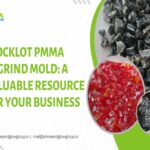Introduction
Acrylic regrind, also known as PMMA (polymethyl methacrylate) regrind, is a versatile and widely used plastic material. It is commonly recycled and reused in various applications, including automotive, construction, and consumer products. As more businesses look to reduce their environmental impact and cut costs, the demand for imported acrylic regrind has grown. However, ensuring the quality of imported acrylic regrind is crucial for achieving optimal performance and maintaining sustainability. In this blog post, we will discuss the importance of quality in imported PMMA regrind and provide some tips on how to ensure it.
Why is Quality Important in Imported Acrylic Regrind?

Performance
High-quality acrylic regrind is essential for producing end products with the desired properties, such as clarity, strength, and durability. When using regrind of low quality, there is a risk of compromised performance, leading to customer dissatisfaction and potential damage to your reputation. To ensure your products meet the required standards and specifications, it is important to prioritize the quality of the acrylic regrind you import.
Cost-effectiveness
While using recycled materials can save costs, it is important to note that low-quality regrind can lead to increased production costs due to inefficiencies and material waste. By ensuring the quality of your imported PMMA regrind, you can minimize these issues and maintain cost-effectiveness. Investing in high-quality regrind may have an initial cost, but it can yield long-term savings by reducing production errors and optimizing material usage.
Environmental impact
One of the main reasons for using recycled materials is to reduce environmental impact. By reusing acrylic regrind, you contribute to the circular economy and conserve valuable resources. However, if the quality of the regrind is poor, it may not be suitable for reuse, leading to waste and undermining the sustainability efforts of your business. To truly achieve environmental benefits, it is vital to ensure that the imported acrylic regrind meets the necessary quality standards.
Tips for Ensuring the Quality of Imported Acrylic Regrind
Source from reputable suppliers
Establishing relationships with reliable suppliers is paramount when it comes to acquiring high-quality acrylic regrind. Look for suppliers who have a history of providing consistent and reliable materials. Before committing to a supplier, verify their certifications, ask for references, and conduct regular audits to ensure they maintain the required quality standards. By working closely with reputable suppliers, you can have confidence in the quality of the imported regrind.
Inspect material upon arrival
Performing thorough inspections of the imported PMMA regrind upon arrival is crucial to identify any potential issues. Check for contamination, color variations, and consistency in size and shape. If possible, conduct laboratory tests to assess the material’s properties, such as melt flow index and impact resistance. By conducting these inspections, you can catch any quality issues early on and take appropriate actions to rectify them.
Establish quality control procedures
Implementing strict quality control procedures is essential to ensure the consistency and quality of the imported acrylic regrind throughout your production process. Train your staff to identify potential issues and provide them with the necessary tools to monitor and maintain quality. This can include visual inspections, sampling and testing, and adherence to established specifications. By establishing robust quality control procedures, you can minimize the risk of using substandard regrind and consistently deliver high-quality end products.
Blend with virgin material
In some cases, blending the regrind with virgin acrylic can help improve the overall quality and performance of the final product. By adding a certain percentage of virgin material to the regrind, you can enhance its properties and overcome any limitations of the recycled material. Determine the appropriate blend ratio for your specific application through testing and monitoring. It is important to strike the right balance between cost savings and maintaining the desired product quality.
Conclusion
Imported acrylic regrind (PMMA) offers many benefits, such as cost savings and reduced environmental impact. However, ensuring the quality of the regrind is crucial for achieving the desired performance and maintaining sustainability. By sourcing from reputable suppliers, inspecting the material upon arrival, implementing strict quality control procedures, and blending with virgin material when necessary, you can ensure the quality of your imported PMMA regrind and create high-quality end products.
FAQs
Q1: Can acrylic regrind be used in food packaging applications?
A1: Acrylic regrind is generally not recommended for food packaging applications due to potential concerns regarding contamination and meeting food safety regulations. It is important to use materials specifically designed and approved for such purposes.
Q2: Is it possible to recycle acrylic products multiple times?
A2: Acrylic products can be recycled multiple times, but the quality and properties of the material may deteriorate with each recycling cycle. It is advisable to blend recycled acrylic with virgin material to maintain the desired performance and quality.
Q3: What are some common contaminants found in acrylic regrind?
A3: Common contaminants found in acrylic regrind include dirt, dust, residual dyes, and other plastic materials. Thorough inspections and testing can help identify and remove these contaminants.
Q4: Can blending virgin material with regrind affect the color consistency of the final product?
A4: Blending virgin material with regrind can help improve color consistency by compensating for any color variations present in the regrind. However, it is essential to monitor the blend ratio and conduct color testing to ensure consistency throughout production.
Q5: What are the main benefits of using acrylic regrind in manufacturing?
A5: The main benefits of using acrylic regrind include cost savings, reduced environmental impact, and the ability to contribute to a circular economy by reusing materials. However, maintaining quality is crucial to fully realize these benefits.
Read More About Stocklot PMMA Regrind Mold: A Valuable Resource for Your Business



